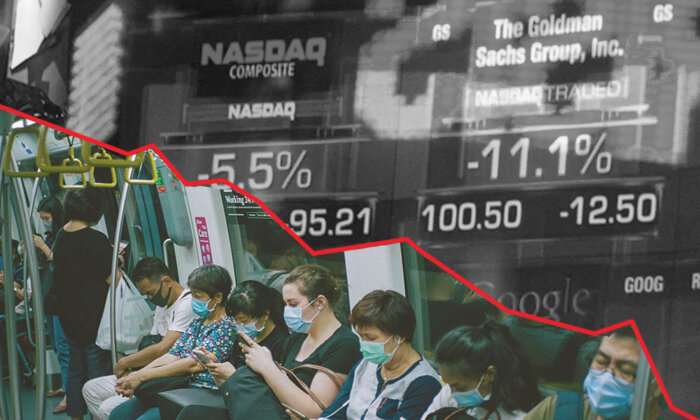Our World Is Interconnected. It’s Time Our Leaders Adapt.

In our righteous anger about the 2008 financial crisis, we focused on the heinous actions of greedy executives, corrupt politicians, and ineffective regulators. Many of our public and business leaders, however, failed to learn the digital age’s first great lesson: Turning a blind eye to risk and forging ahead simply doesn’t work in a turbulent, interconnected world.
Greed and corruption didn’t suddenly arise in the early 21st century, of course. Between 1984 and 1995, Wall Streeters like Ivan Boesky and Michael Milken violated insider trading laws with impunity, receiving mere slaps on their wrists despite bankrupting a major investment bank. A nationwide real-estate bubble emerged and exploded after two major laws deregulated “savings and loans” banks. The FDIC came to the brink of collapse while trying to protect customers when one of the country’s largest banks had to be liquidated, costing taxpayers at least $2.3 billion. The list goes on. Even so, America emerged largely unscathed from this extended ordeal, and the global economy wasn’t destroyed.

So what made the 2008 crisis so different? By then, powerful computers connected global financial organizations. Computer scientists and operations researchers have shown that this network of interconnections enabled the financial contagion to spread rapidly and magnified the Great Recession’s devastations. When computerized trading hammered insurance giant AIG’s share price, for example, it had to make huge payouts even though many of the assets it had insured hadn’t defaulted. That burden bankrupted AIG and damaged all of its clients. Three major Icelandic banks — badly run, but without direct exposure to U.S. debt — collapsed because Lehman Brothers’ bankruptcy sharply raised the price of insurance for loans. Indeed, the only major economies that escaped were the ones that had resisted connecting deeply to the global financial network.
Yet our failure to learn from 2008’s global, human-made crisis continues to haunt 2020’s struggle with a nature-created, human-enabled one. Faced with similarly complex (interdependent, ever-changing) questions and similarly ambiguous (multiple possibilities, each with its own potentially bad consequences) answers, we are repeating old mistakes. In 2008, a sequential effort to prop-up weak institutions failed before governments reluctantly propped up entire industries and economies. This time, we senselessly debated the virtues of local policies instead of adopting regional or national ones.
Faced with similarly complex questions and similarly ambiguous answers, we are repeating old mistakes.
The 2008 crisis took over five years to ameliorate. Today’s pandemic too will pass, but before we can recover, climate change may engender new pandemics and population migrations. Cold War conflicts already abound; hot wars may follow. The urgent need for social justice will give rise to changes that are both essential and have unanticipated consequences. Simultaneously, technologies like the Internet of Things will compound our interconnectedness far beyond the financial world. A different-but-stable normal won’t arise: Turbulence will be the new normal for organizations and nations.
Interconnectedness becomes an existential issue because digital technologies distribute everyday work over time and across geography. People and organizations can’t dissociate from others — digitally or physically — without paying unacceptably high costs. Interconnectedness also magnifies turbulence. Local crises can spread worldwide in milliseconds. Focusing remediation on one node doesn’t work because other nodes can launch shocks. Stopping the progress of a shock by one path of a network isn’t enough, since it can take many others.
Yes, the propagation of viruses in pandemics and shocks in networks are remarkably similar.
Historically, transformative technologies — like today’s digital ones — have necessitated radical changes in how organizations, and even societies, worked, were structured, and led. For example, four decades ago, quality technologies — tools for customer centricity, problem-finding and solution, work control, and many other issues — began transforming businesses globally. Yet, when Japan first introduced them to America, American companies stridently resisted. They didn’t want to devolve power to teams that quality technologies required, or transform their leadership standards. For the prior eight decades, America’s best-known companies had been led by people whom their peers, employees, or journalists called “Prince of Darkness,” “Jack the Ripper,” and “the Pompadoured Bully.” Researchers had grouped them in archetypes like “snake-in-the-grass,” “Attila-the-Hun,” and “heel-grinder.” Starting in the late 1980s, after quality technologies had decimated multiple American industries, the old ways of working became anathema in America (and Europe).
Interconnectedness becomes an existential issue because digital technologies distribute everyday work over time and across geography.
We have already forgotten this history, and today (erroneously) consider teams and empowering leadership ageless. Unless we assimilate the lessons we should have mastered earlier, the effects of the Covid pandemic will last longer. So, what fundamental changes do digital technologies require of today’s leaders? There are three in particular.
First, leaders must be far more inclusive than ever before. A “me first” mentality can’t work since “me” can’t track dispersed points of origin and propagation paths of unanticipated shocks. People at those points are more likely to help if they too will benefit. Our current approach to Covid-19 ignores this reality. Unless the virus is controlled everywhere — as smallpox was — it will be a threat anywhere. Yet, U.S. leaders are focused on divisive for-America-alone strategies, disassociating from global institutions that take a broader perspective.
Second, leaders must enable deeper collaboration than the hackneyed term “win-win” suggests. Digital technologies create many, ever-growing, inevitably distributed, and competing bodies of expertise. Integrating them requires fostering trust among strangers who must collectively balance the lessons and limits of their expertise. Leaders must respectfully “navigate the in-between spaces” to facilitate these relationships. Chancellor Angela Merkel does this so well; she brokers compromise among divergent interests because of her ability to admit what she doesn’t know, and she skillfully delegates decisions.
Unless the virus is controlled everywhere, it will be a threat anywhere. Yet, we are focused on divisive for-America-alone strategies, disassociating from global institutions that take a broader perspective.
Finally, leaders must champion creativity, not simplistic links between assumed causes and presumed effects. Complexity means problem formulations or proposed solutions will inevitably ignore key issues; ambiguity guarantees unintended consequences. In such conditions, traditional decisiveness keeps smart people from asking the “dumb questions” that produce unexpected insights. Politicians everywhere are failing on this standard. For example, the recent discussion about ventilator availability focused on the very expensive ones U.S. hospitals normally use. Though very few other countries could afford those, no one explored whether simple $100 units — designed to U.S. ASTM standards by two MIT students in 2010 — could do the job.
The U.S. government finally got control of the 2008 crisis when its leaders began acting in accordance with these three lessons. For example, they moved from propping up individually failing institutions to buttressing the entire financial sector and took the counter-cultural step of essentially nationalizing GM and Chrysler. They also joined the other major global economies and negotiated the Basel III standards for international banks.
Today, public and business leaders must quickly relearn these lessons. Ironically, the best trained armies — the most hierarchical institutions societies create — learned them first. “For a soldier trained at West Point as an engineer,” wrote retired four-star U.S. General Stanley McChrystal, “the idea that a problem has different solution on different days was fundamentally disturbing.” Perhaps the possibility of perishing opens the human mind to radical change. If so, here too, history offers a valuable lesson: Leaders and organizations who refuse to adapt to the transformative technologies of our times will inevitably be swept aside.
Amit S. Mukherjee is Professor of Leadership and Strategy at Hult International Business School and the author of “Leading in the Digital World: How to Foster Creativity, Collaboration, and Inclusivity”



